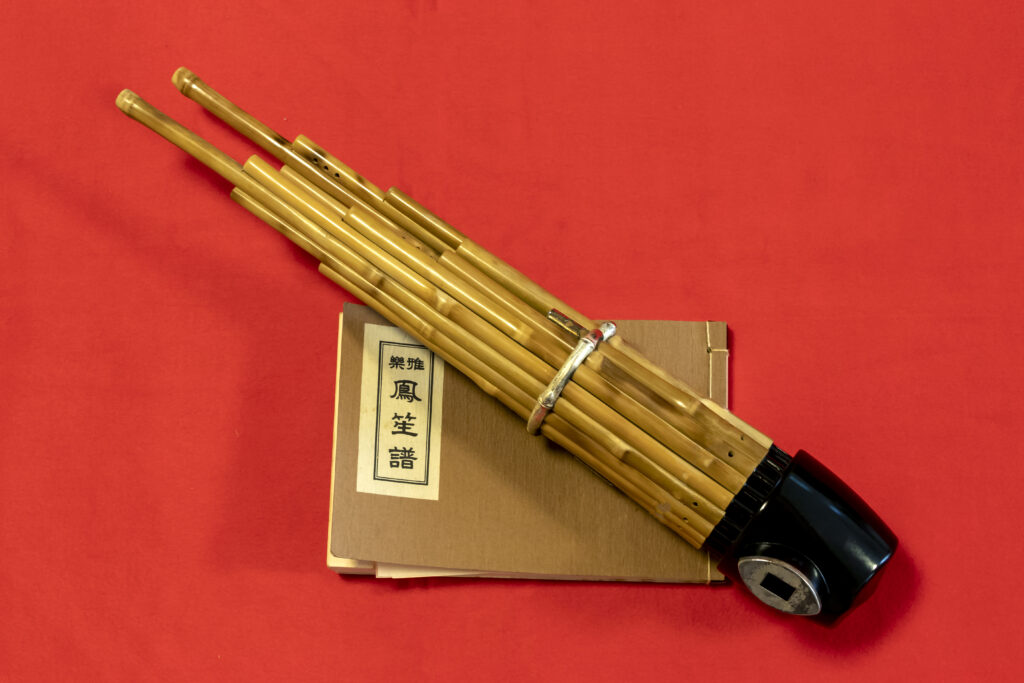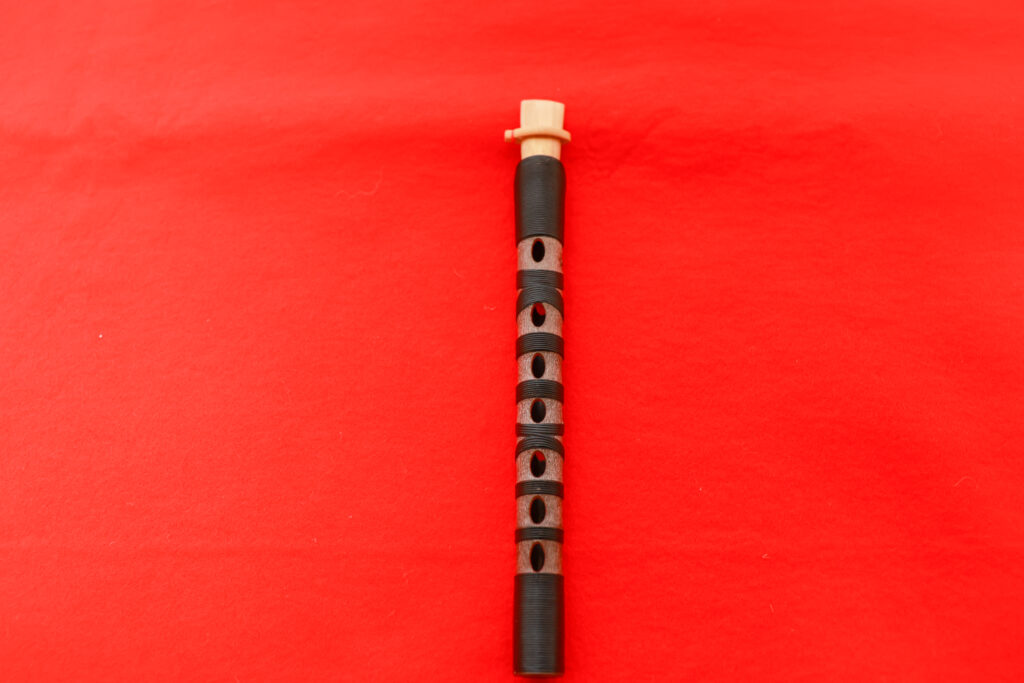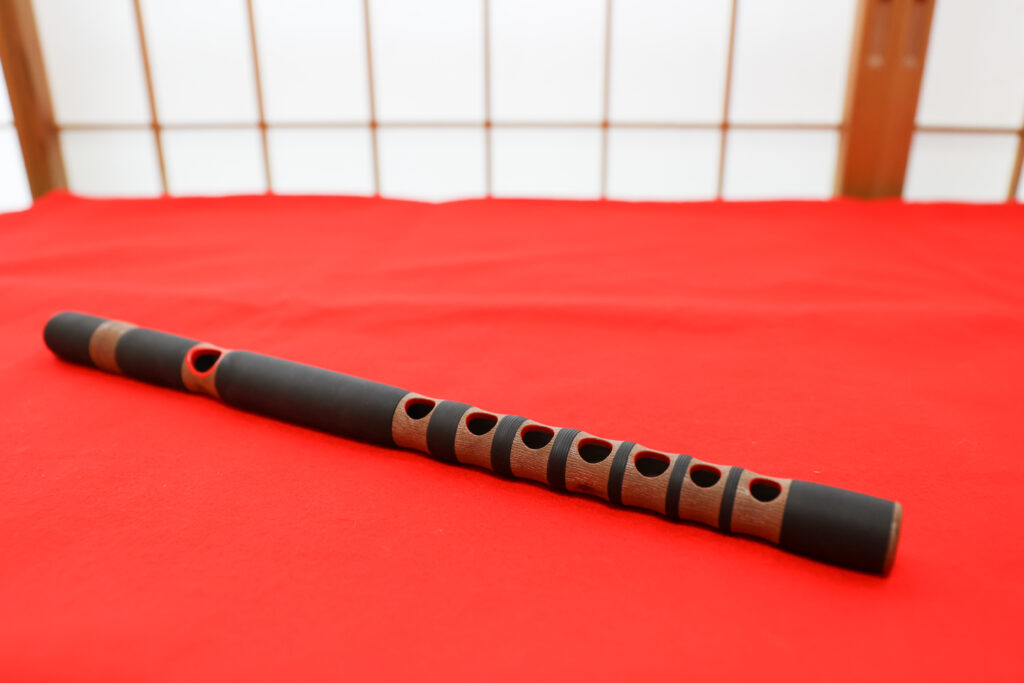Here we explain the instruments used in Gagaku (ancient Japanese court music).

[Overview]
The sho is an instrument used in traditional Japanese gagaku music.
It is the only instrument among traditional Japanese musical instruments that plays chords.
[Mechanism and shape]
The sho is sometimes called a hōshō (=phoenix) because it resembles a phoenix resting on its wings.
It is bowl-shaped (called a kashira) and has a total of 17 bamboo inlays.
Not all of the 17 bamboos, but 15 of them, have small metal reeds (shita) attached to them; these are called free reeds, so they vibrate when the player inhales or exhales, producing a sound.
In wind instruments the sound is generally produced when the sound hole is opened, but the opposite is true of the sho,
which produces its own sound when the sound hole is closed. In other words, the tube does not sound when the hole is left open.
[Tone]
The sound has a softness similar to that of an organ in Western music.
Personally, I have the impression that the sound comes down from the sky and fills the room with light. Legend has it that the instrument was created not only because of its similarity to the fengshang, but also because of its sound, which imitates the sound of the fengshang. It is also said that in ancient China it was recognised as the sound of all things being born and rising.
[Technique]
In classical gagaku, the sho's unique chords (aitake) are played to create a flow that embraces the entire ensemble. Aitake often consists of five or six notes.
[Other features]
The 'head' into which the reed is inserted tends to collect moisture from the player's breath.
To prevent condensation on the reed, it must be constantly warmed by turning the instrument with an electric heater or brazier before playing or while not playing.

[Objective information, summary].
This instrument is mainly used to play the central melody of gagaku.
[Mechanism/Shape]
A vertical flute made of lacquered bamboo, the body of the tube is about 18 cm long and has seven holes in the front and two holes in the back.
It has seven holes in the front and two holes in the back.
The player inserts a reed made of crushed reeds into this tube.
[Sound]
The hichichiriki produces a strong, loud sound that is not as strong as it seems.
Since ancient times, the sound of the hichichiriki has been considered to represent the human voice and the sounds of the earth.
[Technique]
The range of the instrument is narrow and it is characterised by a decorative playing technique called 'embai'.
"Embai" is a soft intonation and pitch changing technique.
The range is about one octave, which is about the range of a normal human voice.
[Other features]
Before playing, the reeds are moistened with tea and adjusted for ease of blowing.

[Objective information, summary]
The ryuteki is a musical instrument of the flute genus, and is often used to play the secondary melody that decorates and colours the hichiriki, which is responsible for the main melody in Gagaku music.
[Mechanism/Shape]
It is about 40 cm long and has a mouthpiece and seven finger holes.
The entire tube, except for the mouthpiece and finger holes, is covered with cherry or rattan bark, which is then coated with lacquer and hardened.
To soften the sound and make it easier to hold while playing, the outer skin of the sooty bamboo is shaved off to form the fingerholes.
[Sounds]
The sound of the dragon flute is said to imitate the cry of a dragon flying between heaven and earth.
It has a light, yet dynamic and powerful tone.
[Technique]
The range (two octaves) is very wide and the melody is characterised by movement.
The melody of the hichiriki is intertwined with the melody of the hichiriki, and at the same time it moves from higher to lower pitches, using the height of its range to add decoration to the melody of the hichiriki.
[Other characteristics].
The dragon flute represents the voice of the dragon that flies between heaven and earth, and is said to symbolise the space between heaven and earth.
[Objective information, summary]
The kakko is a percussion instrument in gagaku (ancient Japanese court music) and is a type of drum. Its role is to set the tempo of the performance and to signal the end.
The kakko player also holds the mallets in his hands as a sign to the other players that the performance is about to begin.
[Mechanism/Shape]
The kakko is made of two pieces of skin, each 23.4 cm in diameter, with a cylindrical drum body,
15 cm in diameter at each end and slightly thicker in the middle, held together by a chashi-o.
The drum body has an arabesque pattern with two peony flowers painted in red and blue. The drum is placed on a black lacquered wooden stand.
[Technique]
The drum is struck with two 39.5 cm long stick-shaped beaters.
There are three ways of playing: mororai, in which both beaters are used on both sides; katarai, in which only one hand is used; and sei, in which only the right beater is used.
These three are played in combination.
[Other characteristics].
The red peony stick is used for celebration, while the blue peony stick is used for condolence when played facing the audience.
In addition, the players who handle the Kakko Tsuzumi are veterans who are familiar with Gagaku.